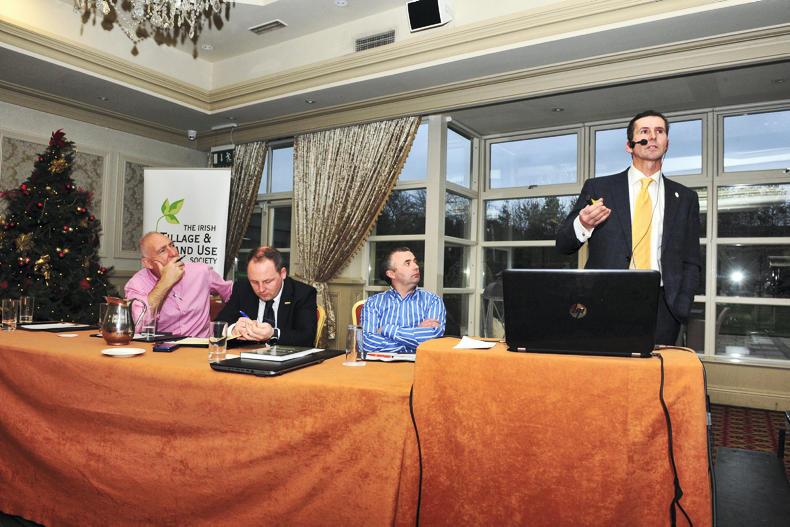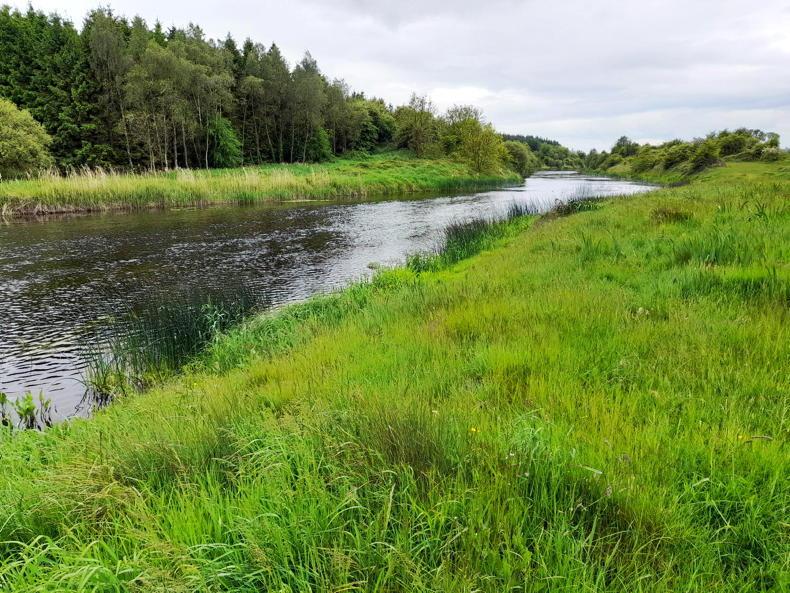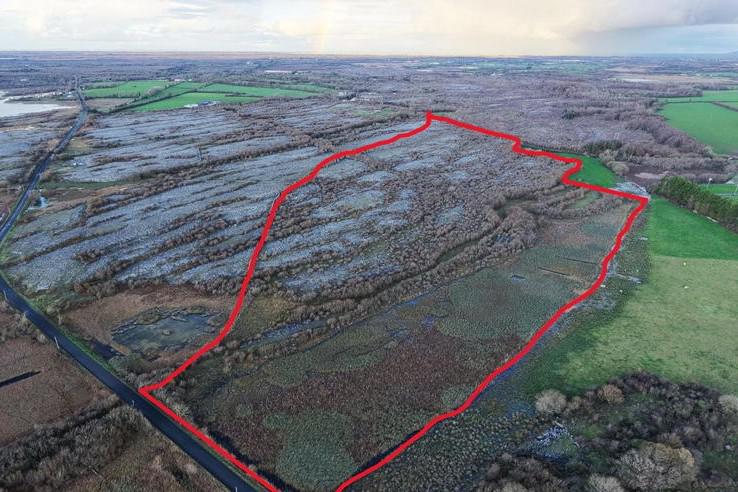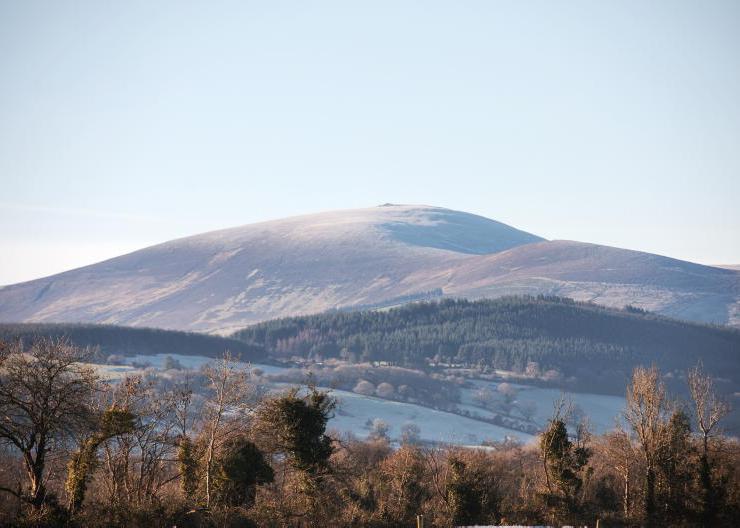Last week’s Irish Tillage and Land Use Society (ITLUS) conference looked towards the future for policy, technology and mechanisation in the tillage sector. This article is the first of two and looks at some of the main pointers from the mechanisation and policy presentations.
The changing drivers of
farm mechanisation
It’s no longer just about power, lifting capacity or power to weight ratio – it’s about connectivity, interaction and being smart. Sounds like a conversation about mobile phones, but it’s actually about farm mechanisation.
The drivers have changed. While the direction of travel still appears to be for bigger, some farmers around the world are now asking for smaller, lighter equipment to help protect our valuable soil and its productive capacity.
Care for the soil
More and more farmers are becoming aware that the limitations of the soil reflect the potential of the crop. Professor Kevin McDonnell from UCD said that root architecture is increasingly recognised as being important in the delivery of potential yield. For roots to function fully, soil must be in good physical and biological condition.
The prevention of soil damage and compaction is a major issue as machines and tools get bigger.
Weather has become increasingly challenging so we are likely to see increased weather-related stresses into the future
Compacted soil decreases the ability of roots to grow and this impacts on yield. Any disturbance system causes damage to soil but the level of damage is influenced by the soil type and how it is impacted by weather.
Weather has become increasingly challenging so we are likely to see increased weather-related stresses into the future, both on the crop and the soil.
In many parts of the world, the combination of larger machine size and tighter weather windows has increased the challenge to get work done. Now lack of labour and skills are also affecting our purchase decisions.
Kevin pointed to the fact that machinery companies are looking at tracks, half-tracks, better tyres, ways to decrease axle loads and even a tyre/track hybrid to help reduce compaction.
He said that lowering tyre pressure in the field can significantly reduce its footprint to reduce pressure on the soil. For this reason, there is considerable interest in systems that enable easy air pressure change from field to road.
While tyres and footwear make some difference to the risk of damage, the better solution remains to decrease axle load
Recent research has shown that cultivation systems can influence moisture level in the top 30cm of soil.
He commented that no-till systems hold more moisture, while deep till and ploughing hold less. So, depending on whether one has a dry time or a wet time, different systems could be either a benefit or a problem.
While tyres and footwear make some difference to the risk of damage, the better solution remains to decrease axle load.
We all know that but it is difficult to do this because of the need for high work rates combined with lack of labour.
Power options
Also speaking at the conference, Darragh Mullin of Case New Holland said that digitisation ultimately means connected, or the potential to be connected, and that the recently introduced ‘T’ series means that “tractors are now self-propelled modems”.
This computing capacity enables all kinds of new control systems and has led to the development of autonomous tractors in different operating configurations.
Such systems vary from guidance (auto steer), coordination (one machine controls another), leader follower (one driver plus slave tractors), supervised autonomy (a person can control a number of vehicles remotely) or full autonomy (the vehicle is empowered to make all the necessary decisions about its actions).
Autonomous tractors already exist in controlled situations such as vineyards or orchards
Kevin said that he did not see fully autonomous tractors here for at least 30 years as there are significant issues to be resolved. Issues such as insurance and risk will be deterrents for some time but Kevin suggested that systems using coordinated controls could provide a halfway house to introduce farmers to autonomy.
However, autonomous tractors already exist in controlled situations such as vineyards or orchards.
A coordinated system is where one driver controls two vehicles for operations such as loading alongside. Kevin suggested that this technology could prove very useful as it could be a big help for older or less skilled operators as labour gets more scarce.
Control systems
Darragh explained that CNH’s latest T series have huge connectivity and individual machines can be viewed from anywhere in the world. Just like a smartphone, software updates can be pushed into the tractors of the future.
These machines are fitted with multiple integrated cameras to help the machine to see and this can result in enhanced safety and ease of operation.
Such features enable advanced precision farming functions for improved efficiency and productivity.
Having machines that are highly interactive enables external digitised control.
Ewan McFarlane is head of digital agronomy at Origin and he is pioneering the use of a range of technologies to help make precise decisions for every single part of a field. This will mean control and coordination between tractor and implement.
Unfortunately, interactive software is not as compatible as we might wish, Kevin said, and this remains a serious issue in slowing the availability of such tools.
Precision is more than just yield
Ewan emphasised that the current genetic potential of winter wheat is around 23t/ha and that an ability to identify and correct as many negative factors as possible will help increase field yields.
Precision is more than just yield. Fields generally receive uniform fertiliser application and patches that yield less leave more N behind, which can then be lost to the environment. Ultimately, all crop yield variability links back to the soil and Ewan showed a raw yield map from the field which carried the recent world record wheat yield.
Even this field showed considerable yield variability, with peaks above 20t/ha and areas less than half that. Headlands, ins-and-outs and field margins were the main yield drag.
Native cereals are a critical element of the feed chain and cereals are an important component of national biodiversity
Tackling all these objectives requires the development of digital understanding, followed by the production of apps and maps to help guide growers and machines. Ewan showed colour-coded field fertility maps which make it easy for the farmer to see problems and progress.
“Native cereals are a critical element of the feed chain and cereals are an important component of national biodiversity. While the EU was concerned about protecting permanent pasture, we in Ireland must be more concerned about preserving our tillage area”, said Bill Callanan, chief inspector at the Department of Agriculture and the Marine.
The competition for land following the ending of milk quotas caused a significant loss of acres from tillage but that seems to have levelled off again for the moment.
Agriculture is being attacked from an environmental and climate change perspective but at least it is producing food. It is still obliged to decrease its greenhouse gas emissions by 10% to 15% and this is a big challenge. This will have to come from a combination of sequestration, peat conservation, our choice and use of energy, plus other actions to decrease emissions.
Other sectors face even bigger challenges. Transport must decrease its emissions by 40% to 50% in the same period. Bill said that this translates to one million electric cars in a current car population of around 2.1 million. But electric cars will still face traffic issues.
Also speaking at the conference was economist Colm McCarthy from UCD. He stated that marine diesel is exempt from fuel tax and that this is a serious food-miles issue.
He also said that aviation fuel is exempt from tax and that this should be seen in a different light to the essential nature of food production.
Lower emissions
Tillage land has lower emissions per hectare using the current metric but it will still have to contribute to the overall national reduction, Bill stated.
Teagasc puts the emission output from the mainly tillage farms in its national farm survey at 2.0t of carbon dioxide equivalent per hectare compared with dairy at 8.4t/ha.
While there are many challenges, Bill commented that there are also potential opportunities
The same report indicated that 75% of the tillage emissions came from the livestock on those farms so it seems that the likely emissions from continuous tillage ground would be closer to 0.5t/ha.
While regulations are a potential driver of change, Bill commented that market forces could prove to be the main driver of change on farms. Once the food chain begins to demand something, it normally happens.
While there are many challenges, Bill commented that there are also potential opportunities.
Government will not prop up a costly renewable system but change could be incentivised through carbon taxes on conventional fuels
There is an increasing consumer awareness of food for health and plants tend to be the starting point. There is considerable interest in protein import displacement to support the livestock sector. Premium markets must continue to be encouraged also.
On the environment, Bill emphasised that while agriculture has issues, it is also part of the solution to the national challenge.
However, entry to the energy market will still be dependent on technologies that reward the farmer directly. Government will not prop up a costly renewable system but change could be incentivised through carbon taxes on conventional fuels.
On the topic of gene editing and new plant breeding techniques, he said that the commission is preparing a report on these topics but it is not due to be completed for another 18 months. However, the fact that technology cannot identify changes is seen as a reason why they should not be legislated for.
He concluded by saying that the commission will put climate front and centre in the new CAP and so things like integrated pest management and reduced chemicals will be a reality for the future.
The direction of technological development in farm mechanisation is clear but it remains to be seen as to what tools will prove useful at farm level.Big data is contributing to development in crop husbandry and machine development.Shortage of labour and challenging weather are affecting machinery development trends.Agriculture must find a narrative to show it is part of the solution to climate change.
Last week’s Irish Tillage and Land Use Society (ITLUS) conference looked towards the future for policy, technology and mechanisation in the tillage sector. This article is the first of two and looks at some of the main pointers from the mechanisation and policy presentations.
The changing drivers of
farm mechanisation
It’s no longer just about power, lifting capacity or power to weight ratio – it’s about connectivity, interaction and being smart. Sounds like a conversation about mobile phones, but it’s actually about farm mechanisation.
The drivers have changed. While the direction of travel still appears to be for bigger, some farmers around the world are now asking for smaller, lighter equipment to help protect our valuable soil and its productive capacity.
Care for the soil
More and more farmers are becoming aware that the limitations of the soil reflect the potential of the crop. Professor Kevin McDonnell from UCD said that root architecture is increasingly recognised as being important in the delivery of potential yield. For roots to function fully, soil must be in good physical and biological condition.
The prevention of soil damage and compaction is a major issue as machines and tools get bigger.
Weather has become increasingly challenging so we are likely to see increased weather-related stresses into the future
Compacted soil decreases the ability of roots to grow and this impacts on yield. Any disturbance system causes damage to soil but the level of damage is influenced by the soil type and how it is impacted by weather.
Weather has become increasingly challenging so we are likely to see increased weather-related stresses into the future, both on the crop and the soil.
In many parts of the world, the combination of larger machine size and tighter weather windows has increased the challenge to get work done. Now lack of labour and skills are also affecting our purchase decisions.
Kevin pointed to the fact that machinery companies are looking at tracks, half-tracks, better tyres, ways to decrease axle loads and even a tyre/track hybrid to help reduce compaction.
He said that lowering tyre pressure in the field can significantly reduce its footprint to reduce pressure on the soil. For this reason, there is considerable interest in systems that enable easy air pressure change from field to road.
While tyres and footwear make some difference to the risk of damage, the better solution remains to decrease axle load
Recent research has shown that cultivation systems can influence moisture level in the top 30cm of soil.
He commented that no-till systems hold more moisture, while deep till and ploughing hold less. So, depending on whether one has a dry time or a wet time, different systems could be either a benefit or a problem.
While tyres and footwear make some difference to the risk of damage, the better solution remains to decrease axle load.
We all know that but it is difficult to do this because of the need for high work rates combined with lack of labour.
Power options
Also speaking at the conference, Darragh Mullin of Case New Holland said that digitisation ultimately means connected, or the potential to be connected, and that the recently introduced ‘T’ series means that “tractors are now self-propelled modems”.
This computing capacity enables all kinds of new control systems and has led to the development of autonomous tractors in different operating configurations.
Such systems vary from guidance (auto steer), coordination (one machine controls another), leader follower (one driver plus slave tractors), supervised autonomy (a person can control a number of vehicles remotely) or full autonomy (the vehicle is empowered to make all the necessary decisions about its actions).
Autonomous tractors already exist in controlled situations such as vineyards or orchards
Kevin said that he did not see fully autonomous tractors here for at least 30 years as there are significant issues to be resolved. Issues such as insurance and risk will be deterrents for some time but Kevin suggested that systems using coordinated controls could provide a halfway house to introduce farmers to autonomy.
However, autonomous tractors already exist in controlled situations such as vineyards or orchards.
A coordinated system is where one driver controls two vehicles for operations such as loading alongside. Kevin suggested that this technology could prove very useful as it could be a big help for older or less skilled operators as labour gets more scarce.
Control systems
Darragh explained that CNH’s latest T series have huge connectivity and individual machines can be viewed from anywhere in the world. Just like a smartphone, software updates can be pushed into the tractors of the future.
These machines are fitted with multiple integrated cameras to help the machine to see and this can result in enhanced safety and ease of operation.
Such features enable advanced precision farming functions for improved efficiency and productivity.
Having machines that are highly interactive enables external digitised control.
Ewan McFarlane is head of digital agronomy at Origin and he is pioneering the use of a range of technologies to help make precise decisions for every single part of a field. This will mean control and coordination between tractor and implement.
Unfortunately, interactive software is not as compatible as we might wish, Kevin said, and this remains a serious issue in slowing the availability of such tools.
Precision is more than just yield
Ewan emphasised that the current genetic potential of winter wheat is around 23t/ha and that an ability to identify and correct as many negative factors as possible will help increase field yields.
Precision is more than just yield. Fields generally receive uniform fertiliser application and patches that yield less leave more N behind, which can then be lost to the environment. Ultimately, all crop yield variability links back to the soil and Ewan showed a raw yield map from the field which carried the recent world record wheat yield.
Even this field showed considerable yield variability, with peaks above 20t/ha and areas less than half that. Headlands, ins-and-outs and field margins were the main yield drag.
Native cereals are a critical element of the feed chain and cereals are an important component of national biodiversity
Tackling all these objectives requires the development of digital understanding, followed by the production of apps and maps to help guide growers and machines. Ewan showed colour-coded field fertility maps which make it easy for the farmer to see problems and progress.
“Native cereals are a critical element of the feed chain and cereals are an important component of national biodiversity. While the EU was concerned about protecting permanent pasture, we in Ireland must be more concerned about preserving our tillage area”, said Bill Callanan, chief inspector at the Department of Agriculture and the Marine.
The competition for land following the ending of milk quotas caused a significant loss of acres from tillage but that seems to have levelled off again for the moment.
Agriculture is being attacked from an environmental and climate change perspective but at least it is producing food. It is still obliged to decrease its greenhouse gas emissions by 10% to 15% and this is a big challenge. This will have to come from a combination of sequestration, peat conservation, our choice and use of energy, plus other actions to decrease emissions.
Other sectors face even bigger challenges. Transport must decrease its emissions by 40% to 50% in the same period. Bill said that this translates to one million electric cars in a current car population of around 2.1 million. But electric cars will still face traffic issues.
Also speaking at the conference was economist Colm McCarthy from UCD. He stated that marine diesel is exempt from fuel tax and that this is a serious food-miles issue.
He also said that aviation fuel is exempt from tax and that this should be seen in a different light to the essential nature of food production.
Lower emissions
Tillage land has lower emissions per hectare using the current metric but it will still have to contribute to the overall national reduction, Bill stated.
Teagasc puts the emission output from the mainly tillage farms in its national farm survey at 2.0t of carbon dioxide equivalent per hectare compared with dairy at 8.4t/ha.
While there are many challenges, Bill commented that there are also potential opportunities
The same report indicated that 75% of the tillage emissions came from the livestock on those farms so it seems that the likely emissions from continuous tillage ground would be closer to 0.5t/ha.
While regulations are a potential driver of change, Bill commented that market forces could prove to be the main driver of change on farms. Once the food chain begins to demand something, it normally happens.
While there are many challenges, Bill commented that there are also potential opportunities.
Government will not prop up a costly renewable system but change could be incentivised through carbon taxes on conventional fuels
There is an increasing consumer awareness of food for health and plants tend to be the starting point. There is considerable interest in protein import displacement to support the livestock sector. Premium markets must continue to be encouraged also.
On the environment, Bill emphasised that while agriculture has issues, it is also part of the solution to the national challenge.
However, entry to the energy market will still be dependent on technologies that reward the farmer directly. Government will not prop up a costly renewable system but change could be incentivised through carbon taxes on conventional fuels.
On the topic of gene editing and new plant breeding techniques, he said that the commission is preparing a report on these topics but it is not due to be completed for another 18 months. However, the fact that technology cannot identify changes is seen as a reason why they should not be legislated for.
He concluded by saying that the commission will put climate front and centre in the new CAP and so things like integrated pest management and reduced chemicals will be a reality for the future.
The direction of technological development in farm mechanisation is clear but it remains to be seen as to what tools will prove useful at farm level.Big data is contributing to development in crop husbandry and machine development.Shortage of labour and challenging weather are affecting machinery development trends.Agriculture must find a narrative to show it is part of the solution to climate change. 









SHARING OPTIONS